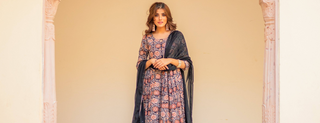Ria Fashions is a well-known Indian fashion internet retailer in the United States. Getting your hands on the best and most up-to-date range of Indian apparel has never been easier. We have a large choice of women's and men's wear to suit your ethnic wear demands, whether you need to attend a wedding or buy festive attire! Ria Fashions is one of the greatest online stores for all your Indian clothing needs. We provide both ready-to-ship and made-to-order choices, so whatever your needs are, we've got you covered! Indian ethnic ensembles come in a wide range of styles. The ones we buy for important events are frequently extravagant and adorned, with a variety of fabrics and intricate designs. Trimmings, weaves, and embroideries that are interesting and sometimes difficult give them their unique charm and texture.
The one thing you need to keep in mind when you purchase heavy Indian clothing is the maintenance. It's difficult to keep them in their top, new-like condition with all the gloss and glitter, metallic borders, materials, and color combinations. Making sustainable choices by investing in the right pieces that fit your occasions and your style is important while you’re creating your ethnic wardrobe. Ria Fashions is your one stop destination for all your wedding or occasion wear needs. Get the latest trends & styles customized to your fit with our made-to-order range. We also offer minor customisable options that can help you create the outfit of your dreams into something that is exactly the way you want.
Here are 5 of the most important points to remember:
-
Carefully follow the instructions for washing and dry cleaning
-
Drying Delicate Indian Traditional Dresses
-
Storing Your Outfits The Right Way
-
Treat your stains immediately, don’t postpone the same.
-
Ensure you don’t use any perfumes, sprays or deodorants on your outfits.
-
Avoid washing your delicate Indian wear after every use.
-
Ensure your outfits are clean & dry before you store them, you can use cloth bags to store them.
-
You can keep changing the folds to make sure that the fabric doesn’t tear from the creases.
WHAT IS THE BEST WAY TO CARE FOR YOUR EXPENSIVE ENSEMBLES AND SAREES?
Keep away from Perfumes, sprays, deodorants, and moth balls.
Pure Zari, which is utilized on the borders of sarees, pallus, dupattas, kurtas, cholis, and blouses, is susceptible to oxidation and chemical exposure.
Weaves made of metal and pure silk threads, such as Banarasi, kimkhab, brocade, Kanjeevaram, and others, are equally vulnerable to environmental deterioration and aerosols.
As a result, exercise extreme caution when wearing or storing these. Make-up, perfumes, hair sprays, deodorants, and face mists, among other things, should be avoided.
HOW TO REMOVE STAINS FROM SAREES AND LEHENGA CHOLI?
In case of stains, treat them as an emergency, do not wait to clean them.
- To remove oil-based stains, sprinkle unscented talcum powder on the stain and let it sit for a few minutes. Remove the blotted powder; wash if necessary.
-Many upmarket brands and designers offer personalised cleaning and stain removal services, for tougher stains. This additional cost may pinch you, but it will ensure that your outfit remains pristine.
- Using petrol as a stain remover with a cotton ball dipped in pure (without oil) petrol to wipe off coffee, tea or gravy stains from your silk sarees.
- After the stain dries completely. Gently rub and remove the dried stain. Use a baby’s brush to dust off the dried material. Blot with talc and wipe gently with a slightly wet satin cloth. Wash or dry clean.
THE COMPLETE GUIDE TO WASHING CARE
The majority of intricate ethnic apparel and thick sarees are labeled 'Dry Clean Only.' Keep a close eye on that.
Dry cleaning: Invest in reputable and reliable dry cleaning services. They may be more expensive, but the extra expense is justified if it protects your priceless garments from damage, fading, or dulling.
Washing Machine - Some silk sarees, particularly those with a high thread count, are washed at home. Washable fabrics include plain georgettes, satins, and mixed fabrics. Use only high-quality, gentle detergents designed exclusively for silks and wools or other moth/rodent repellents in close proximity to these clothing.
Hand wash: Soak your entire outfit completely in the water at one go and rinse it a few times. Now let it remain soaked in water for about 2 hours. You will notice all the dust and dirt slowly coming off. Rinse it in a bucket full of clean water and hang it in the sun to let it dry. Steam iron the entire outfit and store it in the wardrobe.
MAINTAINING THE EMBELLISHMENTS OR EMBROIDERIES
It's not just about the fabric when it comes to lehengas, but also about the work and embroidery. Heavy embellishments, like sequins, gold thread (called zari), bright stones, and even pearls, are common on lehengas. Tissue paper or muslin cloth should be used to wrap a lehenga with heavy designs before keeping it. This will keep the embellishments from becoming tangled up in each other.
Clothes should be stored in a cool, dry, moth-free location away from direct sunlight, and should be folded carefully to avoid unsightly wrinkles. Ironing, in general, necessitates deft manoeuvring to avoid color fading and designs being damaged.
Many people purchase lehenga cholis in USA for a special event and then keep them in their closets for years without wearing them. If that's the case, it's always a good idea to take the lehenga out every few weeks and expose it to sunlight and fresh air. This keeps the look of the outfit fresh and 'new.'
While we can always go ahead and purchase new outfits it is better for you and the environment to take care of what we already own and try to repurpose those in different ways to create new looks each time.


